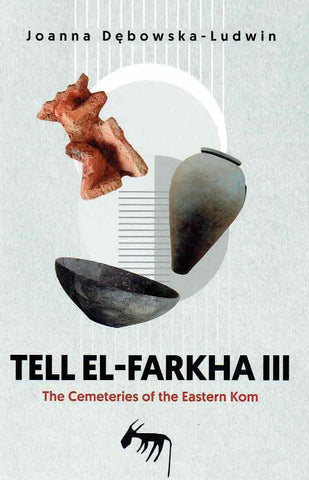Tell el-Farkha III, The Cemeteries of the Eastern Kom
120,00 $
ISBN: 978-83-956708-8-6
Description: hardback, 485 pp. (30x21,5cm), figs.
Condition: new
Weight: 1970g.
Joanna Debowska-Ludwin, Tell el-Farkha III, The Cemeteries of the Eastern Kom, Institute of Archaeology, Jagiellonian University, Krakow 2023
The following richly illustrated pages present 143 burial structures discovered in the Eastern Kom of Tell el-Farkha, the eastern Nile Delta, Egypt, which comprised the remains of 152 individuals. The graves date to the long period between the Protodynastic and the Old Kingdom, that is, ca. 3300 —2600 BC. However, they did not belong to a single burial ground, but to a series of sequentially used smaller cemeteries. In general, materials collected from the sepulchral context of the site are diversified and offer a lot of data useful for discussion on the people, their material culture, burial customs, and — in a further perspective — also on the beginning of the ancient Egyptian civilisation. The situation is especially favourable because of the settlement's proximity which was inhabited by the same people who built the graves and because most of the structures escaped plundering.
The book summarises nearly 20 years of fieldwork conducted at the
Tell el-Farkha cemeteries by the Polish Expedition to the Eastern Nile Delta, which in their large part, although not exclusively, were supervised and published by the author.
1. Preface
Acknowledgements
2. The Site of Tell el-Farkha
2.1. The Settlement in the Time of the Protodynastic Cemetery
2.1.1. Phase 4
2.1.2. Transition from Phase 4 to Phase 5
2.1.3. Pottery Production of Phases 4 and 5
2.1.4. Phase 5
2.1.5. The Economy of the Settlement at the Time of the Protodynastic Cemetery
2.2. The Site at the Time of the Early Dynastic Cemetery
2.3. The Old Kingdom Period at Tell el-Farkha
3. Introduction to the Cemetery in Numbers
3.1. Groups of Graves
3.2. Condition of Graves
3.3. Population
3.3.1. Age-at-Death Curve
3.3.2. Health Condition
3.3.3. Sex and Age Ratio
4. Burials
4.1. Nonanatomical Burials
4.1.1. Postponed Burials
4.1.2. Nonanatomical Burials at Other Early Egyptian Sites
4.2. Subsidiary Burials
4.2.1. Subsidiary Burials in Early Egypt
4.2.2. Significance of the SubsidiaryBurials of Tell el-Farkha
4.3. Multiple Burials
5. Construction Types
S.1. Simple Pits
S.2. Pits with a Partial Lining
5.3. Mud Brick Structures
5.3.1. Pit Lined with Mud Bricks
5.3.2. Mastabas
5.3.2.1 Small Mastabas
S.3.2.2.Regular Mastabas
6. Equipment
6.1. Offerings in Numbers
6.2. Categories of Offerings
6.2.1. Pottery Jars
6.2.1.1.Pottery of NIIIB
6.2.1.2. Pottery of NlllB/C1—2
ó.2.1.3. Pottery of NlllC2/D
6.2.1.4. Pottery as Containers
6.2.2. Jar Sealings
6.2.3. Idols
6.2.4. Other Pottery Items
6.2.5. Animal Bones
6.2.6. Bone Items
6.2.7. Stone Vessels
6.2.8. Cosmetic Palettes
6.2.9. Flint Tools
6.2.10. Other Stone Items
6.2.11. Beads and Pendants
6.2.12. Gold and Copper
6.2.13. Ochre
6.2.14. Charcoal
6.2.15. Other Types of Offerings
6.3. Food as Offering
6.4. Survivorship Bias
7. Cemeteries
7.1. The Protodynastic Cemetery
7.2. The Early Dynastic Cemetery
7.3. The Old Kingdom Cemetery
8. Epilogue
9. Catalogue
10. References

